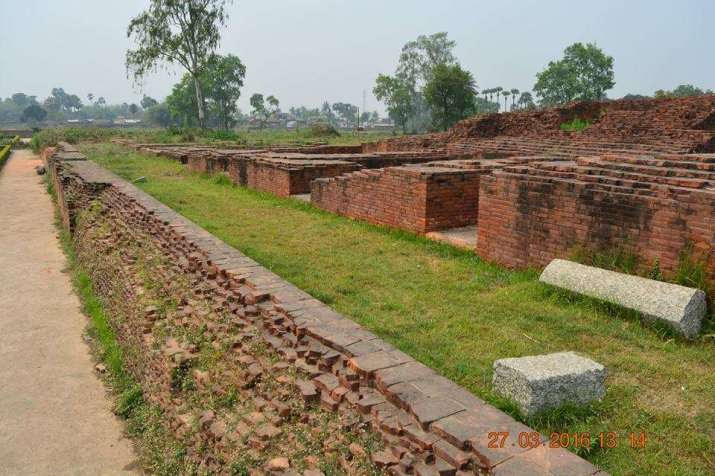By Shyamal Sinha

Vikramaśīla University is one of the two most important centers of Buddhist learning in India, along with Nālandā University during the Pala dynasty. This university was established by King Dharmapala (783 to 820) in response to a supposed decline in the quality of scholarship at Nālandā. Atisha, the renowned pandita, is sometimes listed as a notable abbot.
The Archaeological Survey of India (ASI) has announced that it will develop and conserve the ancient site of Vikramshila University in Bhagalpur District of India’s Bihar State. Vikramshila was once a renowned international Buddhist university, much like Nalanda, also in Bihar, making it a site of historical significance with a rising number of tourists visiting every year.
The project will be completed under the Adarsh Monument Scheme of the Government of India, through which the ASI is improving the condition and the facilities of 100 ancient monuments across the country.
“We have chosen Vikramshila because like the ancient Nalanda University, it was also an elaborate university with international links,” explained D. N. Sinha, superintending archaeologist of the ASI Patna circle. “The monks from here went to Tibet and developed lamaism there. This university was famous for the study of Tantrayana (also known as Vajrayana or Tantric Buddhism).” (The Telegraph India)
Vikramshila, located at Antichak village, some 50km east of the city of Bhagalpur, was established by the emperor Dharmapala (r. c. 783–820) in the late eighth or early ninth century, presumably in response to the declining quality of scholarship at Nalanda University.
Vikramashila was once a centre of Tantrayana Buddhism with more than 100 teachers and thousands of students. Many eminent scholars graduated from the university before moving to other countries, spreading the Buddhist teachings. Atisha Dipankara (982–1054), a renowned Buddhist scholar and founder of the Sarma traditions of Tibetan Buddhism, is said to have been a student.
The university was destroyed when in 1193 when Lakshman Sena, the last Hindu king of Bengal, was vanquished by Bakhtiyar Khilji. According to legend, Khilji forces mistook the university for a fortress and burned it down. The site was forgotten for centuries, until one Lakshmikanta Mishra discovered bricks and structures in a mound at Antichak Village. After he had sent some bricks to Patna University for analysis, the archaeological department of the university, along with the ASI, began excavating the site between 1960 and 1969. The ASI conducted another excavation, unearthing a large square monastery with a cruciform stupa at its centre. The archaeological site is now spread across about 100 acres.
The people of Bhagalpur part of ang desh during Mahabharat period have been demanding better conservation, protection, and development of the site, which will now take place. “There are 208 cells for monks around a courtyard having a stupa in the middle at the Vikramshila site,” Sinha noted. “Around 80 cells have been conserved and NTPC [National Thermal Power Corp] Kahalgaon has helped in it financially as part of the National Culture Fund. At this pace, complete conservation of the site would take 15–20 years. However, under the new project, all the remaining cells will be developed at a fast pace and simultaneously.” (The Telegraph India)
According to ASI sources, the structures of the complex were never fortified after the excavation was completed in 1982, making it vulnerable to external conditions, such as the weather. “Moreover, the firing of bricks used in the main stupa has not been done properly due to which they have developed blackness and are fragile,” an ASI official noted. (The Telegraph India)
During the conservation project, the ASI will also ensure various public amenities, such as a ticket booking complex, souvenir shop, cloak room, interpretation centre with an audio-visual hall, orientation gallery, cafeteria, and toilets.
“The ASI will do the conservation work, while work related to public amenities will be outsourced to public sector agencies like NBCC [National Buildings Construction Corp] or NPCC [National Projects Construction Corp],” Sinha added. (The Telegraph India)
Noting the historical significance of the university, the Indian government announced in August 2015 that it intended to build a new Vikramshila University in Bhagalpur, and that a 5 billion rupee (US$73.7 million) fund had been allocated for its development. The government of Bihar was expected to provide around 500 acres land for the university, but plan is facing hurdles and opposition from local residents. On 3 April 2016, Pranab Mukherjee, then president of India, and Ram Nath Kovind, then governor of Bihar and the current president of India, visited Vikramshila. After the visit Mukerjee talked with Indian prime minister Narendra Modi about the revival of Vikramshila in line with the development of the learning centre at Nalanda.












